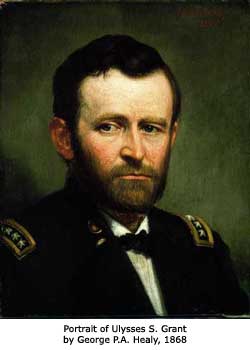 "The
art of war is simple enough. Find out where your enemy is. Get
at him as soon as you can. Strike at him as hard as you can
and as often as you can, and keep moving on." General Ulysses
S. Grant followed his own advice as he waged war for the Union
army between 1861 and 1865.
"The
art of war is simple enough. Find out where your enemy is. Get
at him as soon as you can. Strike at him as hard as you can
and as often as you can, and keep moving on." General Ulysses
S. Grant followed his own advice as he waged war for the Union
army between 1861 and 1865.
Nothing
in Grant's early life marked him for greatness. He attended
West Point but graduated in the lower half of his class. He
left the army in 1854 and when war broke out was a clerk in
a Galena, Illinois, leather goods store.
As
one of the few residents of Illinois with military training,
Grant received a commission as colonel of the 21st Illinois
Volunteers. A series of victories in the West, notably at Forts
Henry and Donelson and Shiloh in 1862 and Vicksburg and Chattanooga
in 1863, led Lincoln to appoint him general-in-chief of the
Union armies.
Unlike General George B. McClellan, Grant fully accepted civilian
rule over the military in matters of policy. After the Emancipation
Proclamation, he worked diligently to ensure African-Americans'
freedom and enlist black soldiers.
Grant began attacking Lee's army in Virginia in May 1864; the
campaign culminated with the siege of Petersburg six weeks later.
Union troops suffered heavy casualties, and critics called Grant
a butcher. In April 1865 Grant forced Lee to surrender.After
the war, Grant served two terms as president, and he wrote an
extremely popular volume of memoirs.


